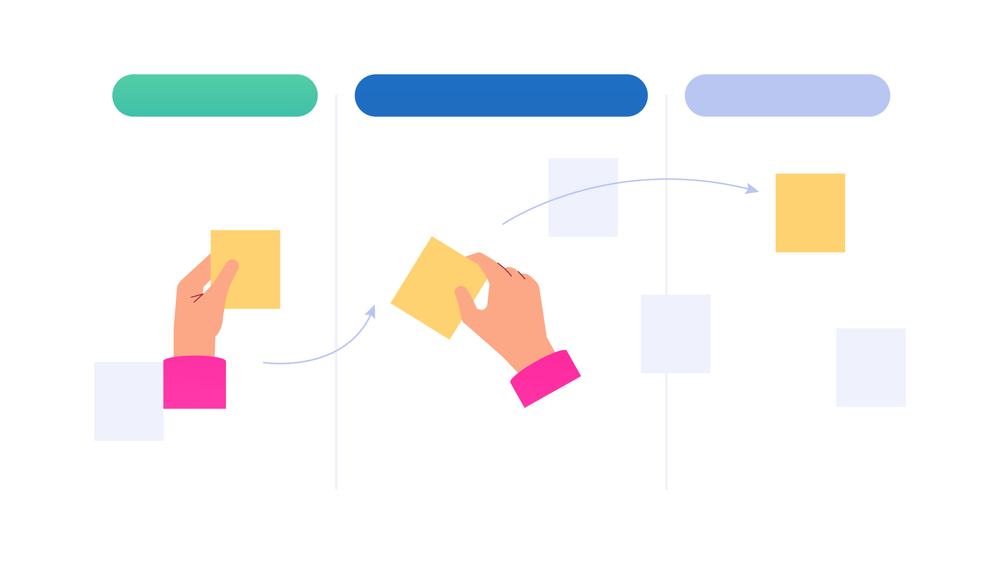How Kanban works for team productivity (and how to succeed with EasyRetro)

The Kanban framework is a visual system for managing work as it moves through a process. That might be organizing your email campaigns, planning an upcoming build, or following a recipe for dinner!
Teams utilizing this method can identify potential bottlenecks — and smooth them right out. That way, work can flow through at an optimal speed while staying cost-effective.
Sounds good, right? In this post, we’ll explain how Kanban works for Agile teams to boost their productivity.
A short history of the Kanban method
Kanban — also spelled “kamban” in Japanese (you’ll see why soon) — roughly translates to “signboard” (that is, any space that’s used to display information). In product development, Kanban is used as a scheduling system that can tell you what to produce, when to produce it, and how much to produce at any given time.
The Kanban board as we know it today actually originated in 1940s Japan when a Toyota engineer — Taiichi Ohno — devised the “kamban” tool as a way of boosting the company’s efficiency and driving its manufacturing capacity to new levels.
Ohno was inspired by the workflows he’d noticed in supermarkets, where items were only re-ordered and added to the shelves when stocks were running low.
His idea quickly took hold across the manufacturing floor — everyone bought into the idea of using physical cards to track which steps had been completed and which team was ready for the next task.
This new way of working transformed the workers’ routines and increased company-wide awareness and accountability.

Since then, Kanban boards have become a cornerstone of Agile working thanks to a little awareness boost brought by David J. Anderson in his groundbreaking book ‘Kanban: Successful Evolutionary Change for Your Technology Business’.
These days, it’s tough to find a company that develops products without a Kanban board by their side!
9 ways Kanban helps improve team productivity
Digital Kanban-based tools (like EasyRetro) boost productivity for virtual teams by creating a shared virtual space where work can live. A digital manifestation of the Kanban framework can also be used within an office setting with great results.
Here are just 9 of the ways that Kanban works to promote productivity.
Better visibility
Kanban’s main feature, the Kanban board, is easily the most recognizable feature of any Agile methodology. Each project has its backlog and every task must go through the product backlog before it can become a deliverable.
Using the Kanban board, a team can easily see how they are progressing through the sprint/project. The simple and easy-to-understand format means that bottlenecks appear on your radar as soon as they form and everyone can take steps to combat them before they become an issue.

Improved efficiency
Even as a project comes to an end, we’re often left thinking “Could we have done more?”. The answer always seems to be “Yes”, but how can you actually achieve that?
Throwing extra resources at a problem is a possible solution, so long as there’s room in the budget, But for a small- and medium-sized business, that’s not often the reality.
But what if you could do more with what you already have?
It doesn’t take long to recognize inefficiencies when you switch to Kanban. The visualization of the process will quickly draw attention to areas where your workflow could be smarter. Once you have identified the issues, you’re already on your way to solving them!
Increased productivity
Once your team is working efficiently, you can start looking at increasing productivity.
And cycle time and throughput are the key metrics for productivity while working with Kanban.
“Cycle time” measures how long it takes for a task to pass through your process, while “throughput” measures how many tasks are delivered during a certain time period. Having a simple way to track your cycle time and throughput reduces discussion as everyone is on the same page — and with just one glance at the board!
Reduced crunch time
Traditional management methods rely on planning upfront and pushing to get all the tasks completed within a set time. This usually ends up with the team crunching during the final stretch — increasing burnout and decreasing morale. Kanban flips that concept on its head. With Kanban, the team only pulls a task into the workflow when another task is completed.
One of the core Kanban practices is imposing work-in-progress limits. When the WIP limit is reached, no new tasks can be added until another task has been completed. These limits prevent the team from being bogged down with too much work.

Increased team focus
WIP limits are also great for improving the team’s focus. After all, they (or you) may think that multitasking is more efficient, but splitting your attention — also known as context switching — comes at a cost.
Context switching can cause from 5 to 30 minutes of wasted time per task, depending on the task and person involved. Kanban benefits team members by letting them focus on a single task at a time rather than having their attention divided between multiple work items at once.
Reduced waste
Eliminating or reducing waste is a cornerstone of lean management. It was an integral feature of the original Toyota Production System — today’s Kanban method.
- “Waste” - Any action that uses resources without adding value.
- “Value” - Something that the customer is willing to pay for.
By using waste and value as the main metrics, your team will start to realize how much time they can save by removing certain actions or conversations.
Flexibility
The joy of any Agile workflow is the flexibility that comes with it.
In a market that moves as quickly as the tech industry does, your team and processes need to be flexible. Responding quickly to changes to the brief is just as crucial as responding to the volatile market.
In this way, using Kanban gives you the flexibility to build a sustainable competitive advantage.
Improved collaboration
Kanban suggests a backlog management process that can help teams become more self-organized while offering transparency and consistency to the decision-making process. This makes it easier for the people who know the most about your processes to operate. And who knows the most about your process? The people working on it day in and day out.
Kanban encourages frequent collaboration between team members. No matter if they’re organizing the day’s priorities in the Daily Standup or trying to get that last bit of coding finished, team members are constantly being encouraged to work together and give their opinion on how to improve current processes.

Improved company culture
Strong collaboration between team members, managers, stakeholders, and customers leads to improved morale and inclusive company culture. Everyone’s opinion is important and valuable — and a good company will realize that early on.
Working with Kanban, the team is able to work independently where needed; using their own initiative is strongly encouraged to achieve maximum efficiency. That allows everyone to unleash their creative ideas and talents.
How Kanban works in EasyRetro
We’ve worked hard to bring you a platform that’s packed full of Agile features while still being accessible to even the newest of Agile workers. EasyRetro’s cloud-based Kanban boards can be accessed anywhere, on any device with multiple sign in options.
Creating a Kanban board is quick and, well, easy. You can see all your existing boards and create new ones right from the EasyRetro dashboard.
With just a few clicks, you can create your own board or select from over 100 templates. All you need to do is:
- Name your board
- Assign the number of votes per team member
- Select an existing template from the drop-down menu or choose to make your own, customized board.
Additional options are available to keep the board in sync with your workflow: disable votes, hide cards, hide vote count, or limit the team to one vote per card.
Once your board is created, you can customize it to your heart’s content. Color code your columns for easier at-a-glance readability, rename the board, add columns, and sort the cards by date, number, order, or even by text. Once you’re all set up, team members can comment and vote on individual cards so the project manager can gain insights from the whole team.
The project manager can even create surveys within the board for quick insights on how the team is getting on.
EasyRetro’s drag-and-drop functionality simplifies the project management process. As soon as a task is complete, it can be dragged into the ‘Completed’ column and, using our Slack integration, the relevant people will instantly be notified of the task’s completion!
Our tools are trusted by thousands of companies from small businesses to Fortune 500 companies. Find out why they put so much faith in our platform by getting started for yourself today!